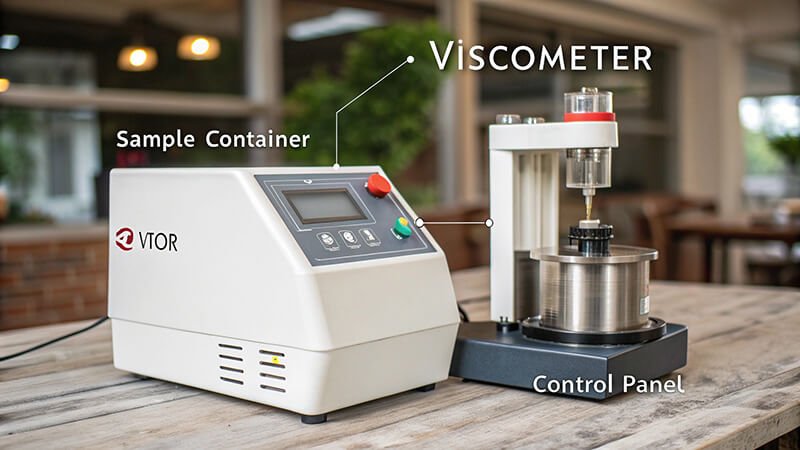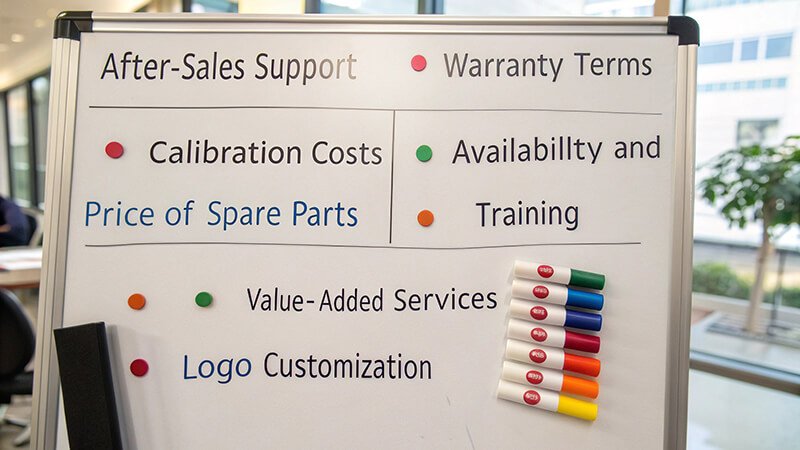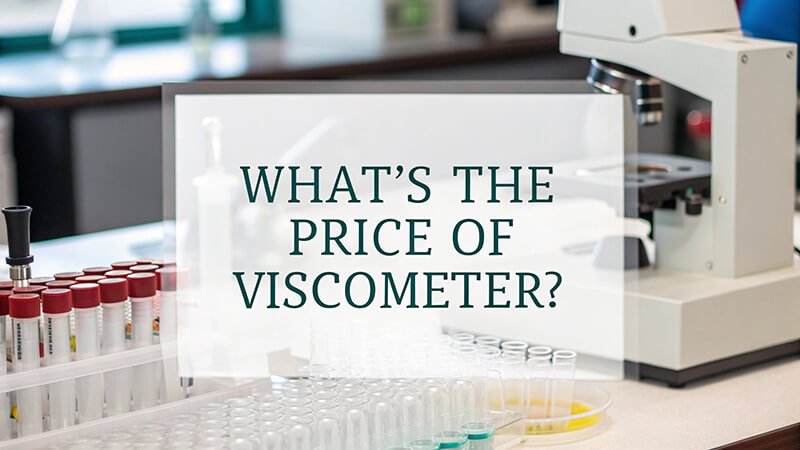Budgeting for a viscometer is confusing. Prices vary wildly, making choices hard. Understanding key factors clarifies viscometer costs for your lab or business.
Viscometer prices range from a few hundred to tens of thousands of dollars. This depends on type, features, automation, brand, and the supplier you choose.
It's a question I hear a lot: "Stefan, why is there such a big difference in viscometer prices?" Many of our customers, like Jacky from Italy who sources rotational viscometers for his distribution business, need to understand this. As a factory, we at Martests aim to help you balance cost with the performance you need, offering transparency. So, let's break down what really goes into the price of a viscometer.
What are the Main Viscometer Types, and How Do Their Prices Generally Compare?
Choosing the right viscometer type feels overwhelming. Different types have vastly different price tags. Know the common types and their typical costs to narrow your search.
Basic glass capillary viscometers are cheapest. Rotational viscometers offer more functionality and vary widely in price. Advanced rheometers, with high precision, are most expensive.
The type of viscometer is the first big factor in its price. Each type works differently and suits different needs.
Common Viscometer Types and Price Ideas
- Glass Capillary Viscometers (e.g., Ostwald, Ubbelohde):
- How they work: Measure the time for a known fluid volume to flow through a narrow tube.
- Price: Usually the lowest, from under $100 to a few hundred dollars for the glass, plus timing devices.
- Good for: Simple, low-volume, Newtonian fluids like solvents.
- Falling Ball/Sphere Viscometers:
- How they work: Measure the time for a ball to fall through a fluid in a tube.
- Price: Can range from a few hundred to a couple of thousand dollars.
- Good for: Transparent liquids, often used in quality control for oils.
- Rotational Viscometers (like ours at Martests):
- How they work: Measure the torque needed to rotate a spindle in a fluid.
- Price: A wide range, from around $1,000 to $15,000+, depending on features.
- Good for: Many fluid types, including non-Newtonian. This is what most of my B2B clients, including distributors in Europe and Southeast Asia, purchase.
- Vibrational Viscometers:
- How they work: Measure the damping of an oscillating probe in the fluid.
- Price: Can be from $2,000 to $10,000+.
- Good for: Process control, continuous measurement.
- Rheometers:
- How they work: More advanced than viscometers, they measure how a liquid or slurry flows in response to applied forces.
- Price: The most expensive, often $20,000 to $100,000+.
- Good for: Detailed R&D, complex fluid behavior.
At Martests, we specialize in rotational viscometers because they offer a great balance of versatility, accuracy, and cost-effectiveness for many industries.
| Viscometer Type | General Price Range (USD) | Key Application Areas |
|---|---|---|
| Glass Capillary | $50 - $500 | Basic lab tests, Newtonian fluids |
| Falling Ball/Sphere | $500 - $3,000 | Transparent liquids, QC |
| Rotational | $1,000 - $15,000+ | Versatile, non-Newtonian, QC, R&D |
| Vibrational | $2,000 - $10,000+ | In-line process control |
| Rheometer | $20,000 - $100,000+ | Advanced R&D, complex materials |
Understanding these types helps you start looking in the right price category for your needs.
Which Key Features, Specifications, and Build Quality Factors Significantly Drive Viscometer Costs Up or Down?
Unsure why some viscometers cost so much more? Extra features, higher precision, and robust build add to the price. Understand what drives cost to make smart choices.
Features like integrated temperature control, wider measurement ranges, higher accuracy, data logging, advanced software, and superior build quality (e.g., stainless steel parts) significantly increase viscometer prices.

Once you choose a type, like a rotational viscometer, features and quality make a big difference in price.
Measurement Range & Accuracy
A viscometer that can measure a very wide range of viscosities (e.g., from thin solvents to thick pastes) costs more. Higher accuracy and repeatability also add to the price. For example, if a client in the pharmaceutical industry needs very precise results, they'll invest more.
Temperature Control
Temperature is critical for viscosity. Built-in temperature control units (like Peltier systems or water baths) add cost but are essential for many applications. Jacky, my Italian customer, often needs this for his clients dealing with oils.
Automation & Software
Automated features, like programmable tests, data logging, and PC connectivity with analytical software, increase the price. These save time and reduce errors, so many larger labs find them worth it.
Build Quality & Materials
The materials used in the viscometer, especially wetted parts (spindles, chambers), affect durability and chemical resistance. Stainless steel is common. Higher-grade materials or specialized coatings for corrosive samples add cost. At Martests, we focus on top quality, ensuring our viscometers last, which is a key selling point for our distributors.
Certifications & Compliance
If a viscometer needs to meet specific industry standards (e.g., ASTM, ISO) or requires calibration certificates traceable to national standards, this can add to the cost.
| Feature/Factor | Impact on Cost | Reason |
|---|---|---|
| Wide Viscosity Range | Higher | More complex sensors, mechanics |
| High Accuracy/Repeat | Higher | Precision engineering, better components |
| Temperature Control | Higher | Added heating/cooling systems, sensors |
| Automation/Software | Higher | Electronics, software development, interface |
| Premium Build/Materials | Higher | Durability, chemical resistance |
| Certifications | Higher | Testing, documentation, compliance processes |
So, a basic rotational viscometer might be at the lower end, but one with a broad range, precise temperature control, and advanced software will be priced higher.
How Does the Supplier (e.g., Factory vs. Distributor) and Order Volume Influence the Final Viscometer Price?
Getting the best price feels like a maze. Supplier markups and order size can change costs. Learn how sourcing and volume affect your final price.
Buying direct from a factory like Martests is often cheaper than from distributors due to fewer markups. Larger order volumes typically secure better unit prices due to wholesale benefits and economies of scale.

Who you buy from and how much you buy also plays a big role.
Factory Direct vs. Distributor
As a factory, Martests can often offer more competitive pricing, especially for B2B wholesale orders. When you buy from a distributor, they add their own margin to cover their costs (storage, marketing, local support) and profit. While distributors provide valuable local services, buying direct can save money if you meet factory MOQs (Minimum Order Quantities). This is why purchasing managers from large instrument distributors often contact us directly.
Impact of Order Volume (Wholesale)
This is simple: buying more usually means a lower price per unit. We have two production lines, so we can handle large orders. For a client like Jacky, who buys rotational viscometers regularly to resell in Italy, placing larger orders means he gets a better price from us, which improves his own profit margins. This is standard in B2B.
Regional Pricing Differences
Prices can also vary by region due to import duties, taxes, shipping costs, and local market competition. A viscometer might have a different final price in Europe compared to Southeast Asia or South America, even if the factory gate price is the same.
| Sourcing Factor | Price Impact | Reason |
|---|---|---|
| Factory Direct | Often Lower | Fewer intermediaries, no distributor markup |
| Distributor | Often Higher | Includes distributor costs and profit margin |
| Large Order Volume | Lower Price Per Unit | Wholesale discount, economies of scale |
| Small Order Volume | Higher Price Per Unit | Less purchasing power, higher per-unit handling |
| Regional Import Costs | Varies (Can be Higher) | Taxes, duties, local shipping added |
I always advise potential customers to discuss their volume needs with us. It helps us provide the best possible quotation.
Beyond the Sticker Price: What Hidden Costs or Value Factors (like Customization or Support) Should I Consider When Comparing Viscometer Prices?
Focusing only on the initial price can be misleading. Hidden costs or lack of support can be expensive later. Look beyond the price tag for true value for money.
Consider after-sales support, warranty terms, calibration costs, availability and price of spare parts, training, and value-added services like logo customization. These significantly impact total ownership cost and value.

The initial purchase price isn't the whole story. A cheaper viscometer might cost you more in the long run.
After-Sales Support & Warranty
What kind of support does the supplier offer? How long is the warranty? Quick and reliable support, especially when exporting to regions like the Middle East or South America, is crucial. If something goes wrong, good support saves time and money. At Martests, we stand by our top quality with solid support.
Calibration & Maintenance
Viscometers need regular calibration to ensure accuracy. Are calibration services easily available and affordable? What about routine maintenance or spare parts like spindles? These are ongoing costs.
Customization (Logo)
For distributors like Jacky, a key value is being able to sell products under their own brand. We offer customization, like adding their company logo to the viscometers. This service, while it might have a small initial cost, adds significant value for their resale business. This is a big part of our wholesale model.
Training & Usability
Is the viscometer easy to use? Does the supplier offer training? A complex instrument that staff can't use properly is a wasted investment.
Shipping & Import Duties
Remember to factor in shipping costs from the supplier (especially if they are in China like us) and any import duties or taxes in your country. These can add a significant percentage to the landed cost.
| Value Factor / Hidden Cost | Importance for Total Cost | What to Look For |
|---|---|---|
| After-Sales Support | High | Responsive, knowledgeable support, clear warranty terms |
| Calibration/Maintenance | Medium (Ongoing) | Availability, cost of services and parts |
| Customization (e.g., Logo) | High (for Distributors) | Factory capability, quality of customization |
| Training/Usability | Medium | Ease of use, available training materials/sessions |
| Shipping & Import Duties | Medium to High | Clear shipping quotes, awareness of local import costs |
Thinking about these factors helps you compare viscometers not just on price, but on overall value and suitability for your business.
Conclusion
Viscometer price is a mix of type, features, supplier, and value-adds. Understanding these helps you find the best instrument that fits your budget and technical needs.


